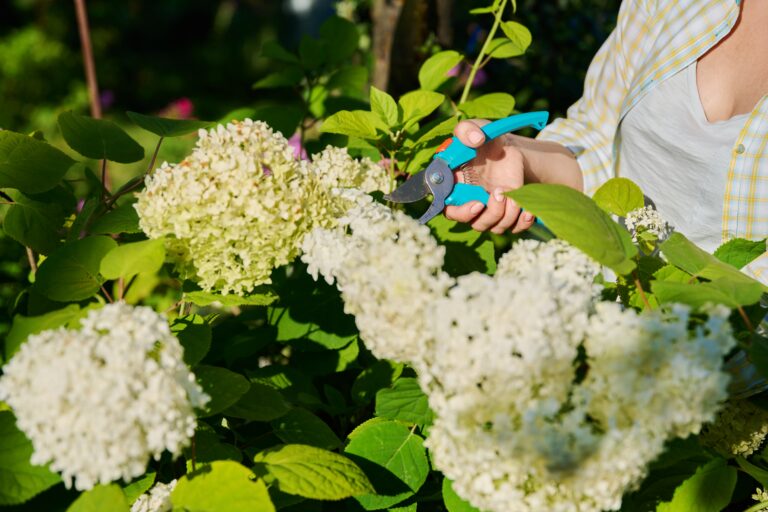Table of Contents
Hydrangeas are beloved for their stunning blooms and lush foliage, making them a favorite in many gardens. However, to ensure these plants remain healthy and continue to produce vibrant flowers, proper pruning is essential. Knowing when and how to cut back hydrangeas can significantly impact their growth and the quality of their blooms. This comprehensive guide will walk you through the best times and methods to prune your hydrangeas, helping you maintain a beautiful and thriving garden. Our previous blog provides tips on When and How to Prune Lilac Bushes and The Ultimate Guide to Trimming Bushes. Here you will understand fundamental aspects for a successful and fulfilling journey into the world of bush trimming.
Why Prune Hydrangeas?
Pruning hydrangeas serves several important purposes:
1) Health and Vigor
Removing dead or diseased wood prevents the spread of pests and diseases, allowing the plant to channel energy into new growth. This helps the plant remain healthy and vigorous, ensuring that it continues to produce strong stems and leaves.
2) Shape and Size
Pruning helps maintain a manageable size and attractive shape, preventing the plant from becoming too large or unruly. By controlling the shape and size, you can ensure that your hydrangea fits well within your garden’s design and doesn’t overshadow other plants.
3) Improved Blooms
Regular pruning encourages the production of larger, more vibrant flowers by promoting healthy new growth and removing old, unproductive wood. This can result in more spectacular blooms and a more visually appealing plant.
4) Air Circulation
Thinning out the plant improves air circulation, reducing the risk of fungal infections and promoting overall plant health. Good air circulation can help prevent diseases like powdery mildew and botrytis, which can affect the leaves and flowers.
When to Prune Hydrangeas
The timing of hydrangea pruning depends on the type of hydrangea you have, as different species have different blooming patterns. Here are the general guidelines for the most common types:
1) Bigleaf Hydrangeas
These hydrangeas bloom on old wood, meaning the flower buds are formed in the previous year. The best time to prune bigleaf hydrangeas is immediately after they finish blooming in the summer. This timing allows the plant to set new buds for the following year without interruption. Avoid pruning in the fall, winter, or spring, as this can remove the developing buds.
2) Panicle Hydrangeas
These hydrangeas bloom on new wood, so you can prune them in late winter or early spring before new growth begins. This encourages the plant to produce strong new stems and large flower clusters. You can cut them back by one-third to one-half of their height, which helps control their size and shape while promoting vigorous growth.
3) Smooth Hydrangeas
Similar to panicle hydrangeas, smooth hydrangeas bloom on new wood and can be pruned in late winter or early spring. This will result in larger blooms on the new growth. Cut back the stems to about 12 to 18 inches from the ground to encourage robust growth and large flowers.
4) Oakleaf Hydrangeas
These bloom on old wood, so pruning should be done immediately after flowering, similar to bigleaf hydrangeas. Pruning too late can remove the buds for the next year’s flowers. Light pruning to remove spent flowers and shape the plant is usually sufficient. Avoid heavy pruning, as oakleaf hydrangeas can be slow to recover and may not bloom the following year if pruned too severely.
How to Prune Hydrangeas
Effective pruning involves removing dead or damaged wood, thinning out crowded branches, and shaping the plant to encourage healthy growth. Here’s a step-by-step guide:
1) Tools Needed
Use sharp, clean pruning shears to make precise cuts and prevent the spread of disease. Long-handled loppers and a pruning saw may also be useful for thicker branches. Sterilize your tools with rubbing alcohol or a bleach solution before and after use to prevent disease transmission.

2) Remove Dead Wood
Start by cutting away any dead or damaged branches. This helps to prevent disease and pest infestations. Look for branches that are brown, dry, and brittle. Removing these branches allows the plant to focus its energy on healthy growth.
3) Thin Out
For older hydrangeas, remove a few of the oldest stems at the base each year. This encourages new growth and improves air circulation. Aim to keep the center of the plant open to light and air. Thinning out crowded branches can also help prevent fungal diseases and make the plant more aesthetically pleasing.
4) Shape the Plant
Trim back branches to maintain the desired shape and size of the plant. Be careful not to remove too much at once, as this can stress the plant. Aim for a balanced, natural shape. Prune back to a pair of healthy buds to encourage new growth and maintain the plant’s form.
5) Prune for Bloom
Depending on the type of hydrangea, follow the timing guidelines to ensure you are not cutting off next year’s flower buds. For example, avoid late-season pruning on bigleaf and oakleaf hydrangeas, as this can remove buds that have already formed. Pruning at the right time ensures a full display of blooms the following season.
Pruning Tips for Specific Hydrangea Types
- Bigleaf Hydrangeas: After the summer bloom, remove spent flowers and prune back to a pair of healthy buds. This helps shape the plant and encourages new growth. Avoid heavy pruning in the fall, as this can reduce next year’s blooms.
- Panicle Hydrangeas: In late winter or early spring, cut back stems to about one-third of their height. This encourages new growth and larger blooms. You can also remove any weak or crossing branches to improve the plant’s structure.
- Smooth Hydrangeas: Cut back stems to the ground in late winter or early spring. This drastic pruning results in vigorous new growth and large flower clusters. This type of hydrangea can handle more severe pruning without negatively impacting its blooms.
- Oakleaf Hydrangeas: After blooming, remove spent flowers and prune back to a pair of healthy buds. Avoid heavy pruning, as oakleaf hydrangeas can be slow to recover. Light pruning to shape the plant and remove any damaged or diseased wood is usually sufficient.

Common Mistakes to Avoid
- Pruning at the Wrong Time: Pruning at the wrong time can result in the loss of flower buds, leading to fewer blooms. Always identify your hydrangea type and follow the specific pruning guidelines. Incorrect timing can significantly impact the plant’s ability to flower.
- Over-Pruning: Removing too much foliage can stress the plant and reduce its ability to produce flowers. Aim for gradual, balanced pruning over time. Over-pruning can weaken the plant and lead to fewer, smaller blooms.
- Ignoring Dead Wood: Failing to remove dead or diseased wood can lead to pest infestations and health problems. Regularly inspect and clean up your plants. Dead wood can harbor pests and diseases that can spread to healthy parts of the plant.
- Improper Tools: Using dull or dirty tools can cause damage to the plant and spread disease. Keep your pruning shears sharp and clean. Clean, sharp cuts heal faster and reduce the risk of infection.
Conclusion
Pruning hydrangeas correctly is crucial for maintaining their health and ensuring vibrant, plentiful blooms year after year. By understanding the specific needs of your hydrangea type and following the appropriate timing and techniques, you can enjoy a lush, colorful garden. Regular pruning not only keeps your hydrangeas looking their best but also promotes strong, robust growth, making them a standout feature in your landscape. Happy gardening!
Regular maintenance and attention to detail can make a significant difference in the health and beauty of your hydrangeas. With the right care, your hydrangeas will reward you with stunning blooms and lush foliage, adding beauty and elegance to your garden. For more detailed information and tailored advice, visit our page on trimming services. For support on your next trimming project, please feel free to reach out through our contact form, and our team will be happy to help.



